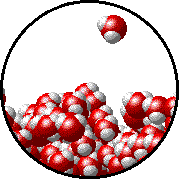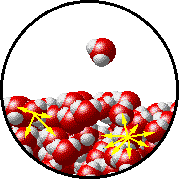explain with eg surface tension &viscocity
Surface tension:
Surface tension is a property of the surface of a liquid that allows it to resist an external force.It is revealed, for example, in floating of some objects on the surface of water, even though they are denser than water, and in the ability of some insects (e.g. water striders ) to run on the water surface. This property is caused by cohesion of like molecules, and is responsible for many of the behaviors of liquids. Water has adhesion/ cohesion properties (attributed to Van der Waal forces) and these give water its tendency to "clump" together and stick to surfaces. To visualize this, imagine a drop of water rolling down glass. It remains a drop instead of spreading out and it will stick to the glass instead of falling if turning upside down. Similarly, when an object is placed onto water, it behaves to a certain degree as if it were a sheet of elastic material. This is called surface tension and can be readily observed by placing a piece of grass on water. As water tends to stick to itself, it can be thought of as a sheet - when the density is too great the sheet will "snap" (or sink) but otherwise it can support it (float).
- Viscosity :
Viscosity is a measure of the resistance to flow that a fluid offers when it is subjected to shear stress. It is commonly perceived as "thickness", or resistance to pouring. Viscosity describes a fluid's internal resistance to flow and may be thought of as a measure of fluid friction. Thus, water is "thin", having a lower viscosity, while vegetable oil is "thick" having a higher viscosity.
In simple words, it is the resistance of a fluid to flow. For example, water has a low viscosity, when you pour it, it quickly drops into the cup; syrup has a high viscosity; it doesn't pour out nearly as easily as water.



